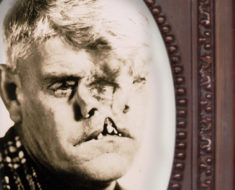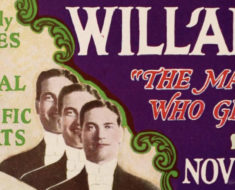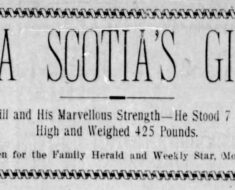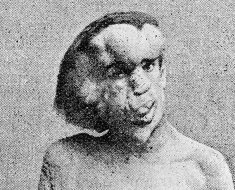Stone-eaters have been munching on rocks for at least a thousand years. In Harry Houdini’s Miracle Mongers and Their Methods (1920), he quotes a passage from Wanley’s Wonders of the Little World (1906), which told the story of a man in Prague who reportedly ate stones for cash in the year 1006, and “was sensible of no injury to his health thereby.”
There have been many others since.
In the 1600s, a man named Thomas Gobsill was advised to eat pebbles to relieve his flatulence problem. As explained in Kirby’s Wonderful and Eccentric Museum (1820), “The stones passing easily through him, he found great relief from the practice.” Eventually, he suffered a “violent fit” and the swallowing of his usual nine stones didn’t help. So he swallowed nine more. And then another nine. He kept swallowing them until more than two hundred filled his belly. He could shake and hear them rattle.
After two years of walking around like a bag of rocks, Gobsill visited a new doctor to complain about the stones and his inability to digest other foods, though did not appear to get any help: “He had been under the hands of several quacks, but all the medicines they employed could never bring from him a single stone.”
While Gobsill appeared to have received horrible medical advice which developed a bad habit and worsened his condition, most stone-eaters were performers, like the man in Prague Houdini reported.
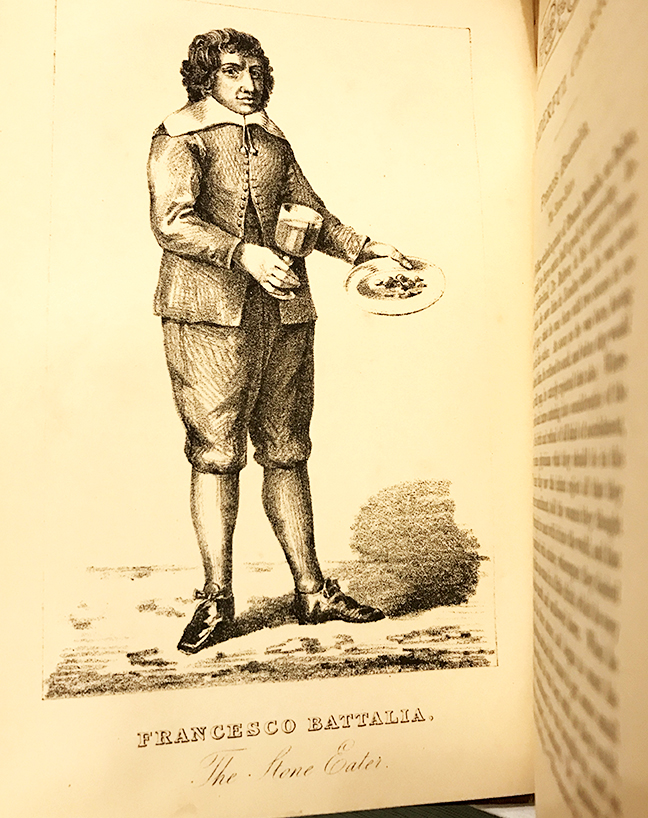
Francesco Battaglia, one of history’s extraordinary Stone-Eaters, as illustrated in The Book of Remarkable Characters, by Henry Wilson and James Caulfield.
Perhaps the most famous of these showmen was another 17th-century man, named Francis Battalia, known to perform at the Bartholomew Fair in London.
His case is described in James Caulfield and Henry Wilson’s The Book of Wonderful Characters (1869), which describes a report in Dr. John Bulwer’s Artificial Changeling (1650): “… he was born with two stones in one hand, and one in the other. As soon as he was born, having the breast offered him, he refused to suck, and when they would have fed him with pap, he utterly rejected that also.”
Battalia’s parents, as the tales goes, were told by physicians that the child “was to be nourished with stones.” The boy finally found something he liked and was raised on rocks and beverages to wash them down.
His manner is to put three or four stones into a spoon, and so putting them into his mouth together, he swallows them all down one after another; then (first spitting) he drinks a glass of beef after them. He devours about half a peck of these stones every day, and when he chinks upon his stomach, or shakes his body, you may hear the stones rattle as if they were in a sack, all which in twenty-four hours are resolved.”
Dr. Bulwer expanded on his story by describing Battalia’s pooping habits: “Once in three weeks he voids a great quantity of sand, after which he has a fresh appetite for these stones, as we have for our victuals, and by these, with a cup of beer, and a pipe of tobacco, he has his whole subsistence.”
Bulwer did not state whether or not he witnessed Battalia’s excrement for himself.
Caulfield and Wilson also write of a stone-eater who exhibited his unusual appetite in London in 1788. An advertisement for his act read:
An Extraordinary Stone-Eater.
The Original
STONE-EATER
The Only One in the World,
Is arrived, and means to perform this, and every day (Sunday excepted),
at Mr. Hatch’s, Trunk Maker, 404, Strand, opposite Adelphi.
STONE-EATING
and
STONE-SWALLOWING,
and after the Stones are swallowed, may
be heard to clink in
his Belly, the same as in a Pocket.
The present is allowed to be the age of Wonders and Improvements in the Arts. The idea of a Man’s flying in the Air, twenty years ago, before the discovery of the Use of Balloons, would have been laughed at by the most credulous! Nor does the History of nature afford so extraordinary a Relation as that of a Man’s EATING and subsisting on PEBBLE FLINTS, TOBACCO PIPES, and Mineral Excrescences: but so it is, and the Ladies and Gentlemen of this Metropolis and its vicinity have now an opportunity of witnessing this extraordinary Fact by seeing the most Wonderful Phenomenon of the Age, who GRINDS and SWALLOWS STONES, &c., with as much ease as a Person would crack a nut, and masticate the kernel.
This Extraordinary Stone-Eater appears not to suffer the least Inconvenience from so ponderous, and to all other persona in the World, so indigestible a Meal, which he repeats from twelve at noon till seven.
Any Lady or Gentleman may bring Black Flints or Pebbles with them.
N.B.—His Merit is fully demonstrated by Dr. Munro, in his Medical Commentary, 1772, and several other Gentlemen of the Faculty. Likewise, Dr. John Hunter and Sir Joseph Banks can witness the Surprising Performance of this most Extraordinary STONE-EATER.
Admittance—Two Shillings and Sixpence.
A Private Performance for Five Guineas, on a short notice.”
Of course, stone-eaters such as this fellow didn’t actually eat stones. As Houdini discovered for himself, such performers developed powerful skills of regurgitation allowing them to bring objects up at their command. After they swallowed stones, they could cough them up later—offstage. Houdini learned the act from a performer with the Welsh Bros. Circus in 1895.
![Harry Houdini, By Dutton and Co. [Public domain], via Wikimedia Commons](http://www.weirdhistorian.com/wp-content/uploads/2017/10/Houdini_-_Miracle_Mongers_-By-Dutton-and-Co.-Public-domain-via-Wikimedia-Commons.jpg)
Harry Houdini, By Dutton and Co. [Public domain], via Wikimedia Commons
Around this time, a French performer, Mac Norton, was doing a regurgitation act with various objects, most notably frogs. He’d swallow them and bring them back up, alive and well. This earned him the nickname, The Human Aquarium.
Houdini recalled an occasion in Norton’s dressing room after a show when things didn’t quite go according to plan: “It seems he had lost a frog—at least he could not account for the entire flock—and he looked very much scared, probably at the uncertainty as to whether or not he had to digest a live frog.”
Not long after Norton, the Great Waldo rose to fame with the same powers of regurgitation. Waldo swallowed frogs, too, but was better known for dropping live mice down his gullet. Read more about him in this earlier Weird Historian post.
Today’s version is Scotland’s Stevie Starr, a recent finalist on America’s Got Talent. He not only swallows live creatures, but also enjoys eating plenty of other objects that no one else should ever try swallowing, including coins, billiard balls, nails, and quite surely, stones.

